You can extend the functionality and capacity of a base ArcGIS Enterprise deployment by licensing and adding other capability-based servers. Adding server machines on premises or in the cloud to your ArcGIS Enterprise deployment will help you make the most of available functionality in your organization.
In a base deployment configuration, users access your web GIS resources through the portal. Administrators and publishers can access ArcGIS Server directly for their purposes.
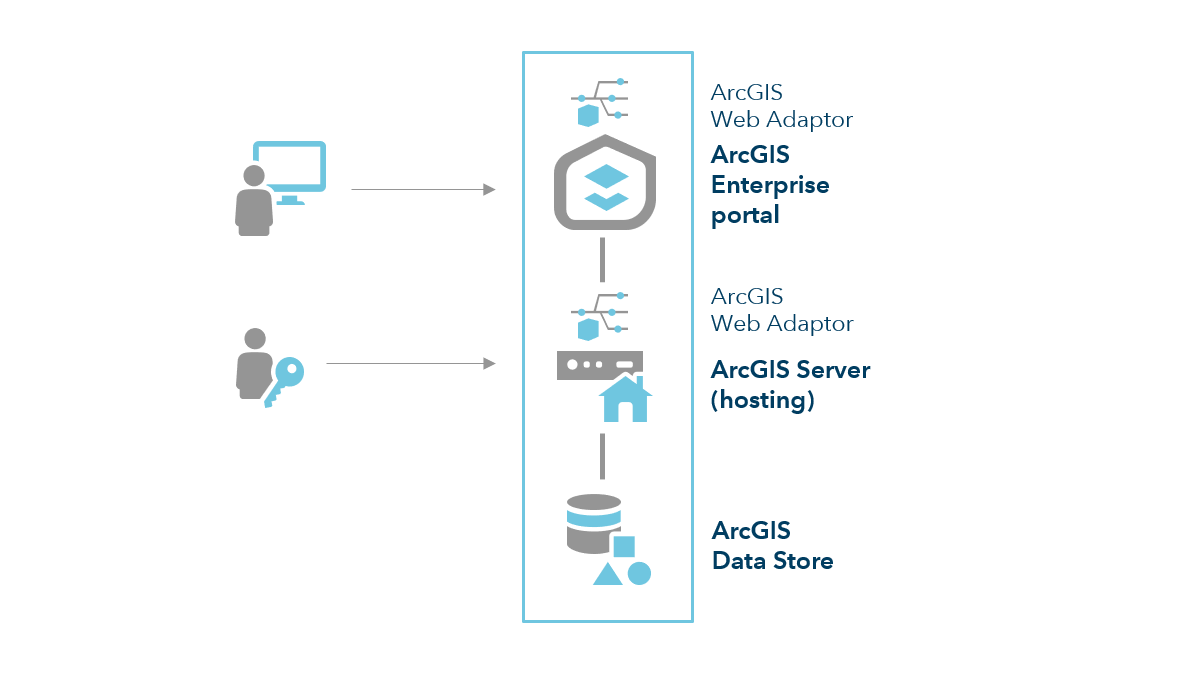
- Learn more about a base ArcGIS Enterprise deployment.
When you want to extend a base deployment to include additional servers, there are may be unique guidelines for each server type, including storage requirements and the optimal amount of servers to include in a site. Details for each server are provided.
ArcGIS GIS Server
In the base ArcGIS Enterprise deployment, ArcGIS GIS Server acts in two distinct capacities:
- The hosting server that supports the overall Web GIS infrastructure
- A general purpose GIS Server, where services can be published that reference your own data sources, such as geodatabases
Many organizations separate these functions into two distinct ArcGIS Server sites to improve the performance of their deployment.
In this configuration, an additional three-machine ArcGIS GIS Server site is federated with your portal. This additional site provides dedicated mapping and visualization capabilities to your users. The number of machines in each site will be dictated by your needs for capacity and high availability.

Each machine in the ArcGIS GIS Server site requires a minimum of 8 GB of memory, with more potentially required depending on the number of services published and their usage patterns.
- Learn more about ArcGIS GIS Server capabilities and extensions.
ArcGIS Data Pipelines Server (beta)
ArcGIS Data Pipelines Server (beta) is a no-code, visual data engineering capability that makes it easy to prepare and integrate data for mapping and analysis workflows.
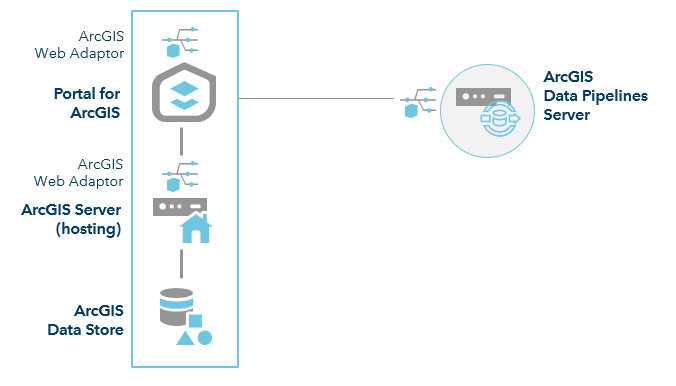
To accommodate many data pipeline authors, or to provide each author with more resources for running data pipelines, you can join additional machines to an ArcGIS Data Pipelines Server site.
- Learn more about ArcGIS Data Pipelines Server system requirements.
ArcGIS GeoEnrichment Server
An ArcGIS GeoEnrichment Server is available with ArcGIS Business Analyst Enterprise, which is a software solution bundle that combines demographic, lifestyle, behavioral, and spending data with location-driven analytic capabilities. You can use maps, infographics, and analyses to make market planning, site selection, and customer targeting decisions.

ArcGIS GeoEvent Server
ArcGIS GeoEvent Server enables real-time, event-based data streams from sensor networks—whether stationary, mobile, or an Internet of Things (IoT)—to be integrated as data sources in your enterprise GIS.
The ideal number and configuration of ArcGIS GeoEvent Server instances for your deployment depends wholly on your data stream or streams—their event velocity and the data size of each event. A single instance of ArcGIS GeoEvent Server can process a stream with a volume of up to 6,000 events per second if the event data size only includes a few data fields and a point. The same hardware and software configuration may only be able to process 2,000 events per second if each event includes several dozen data fields and a many-sided polygon. The type and number of processors incorporated into an event processing workflow will also affect the number of event records you can process each second.
The recommended minimum setup includes a base ArcGIS Enterprise deployment installed and configured on one or more machines, ArcGIS Data Store configured on a second machine, and an ArcGIS GeoEvent Server site deployed on a third.
Note:
Incorporating a three-node spatiotemporal big data store enables high-velocity and large-volume archiving of event data processed by ArcGIS GeoEvent Server. The relational data store type in ArcGIS Data Store can handle data streams with an event volume below 200 events per second.
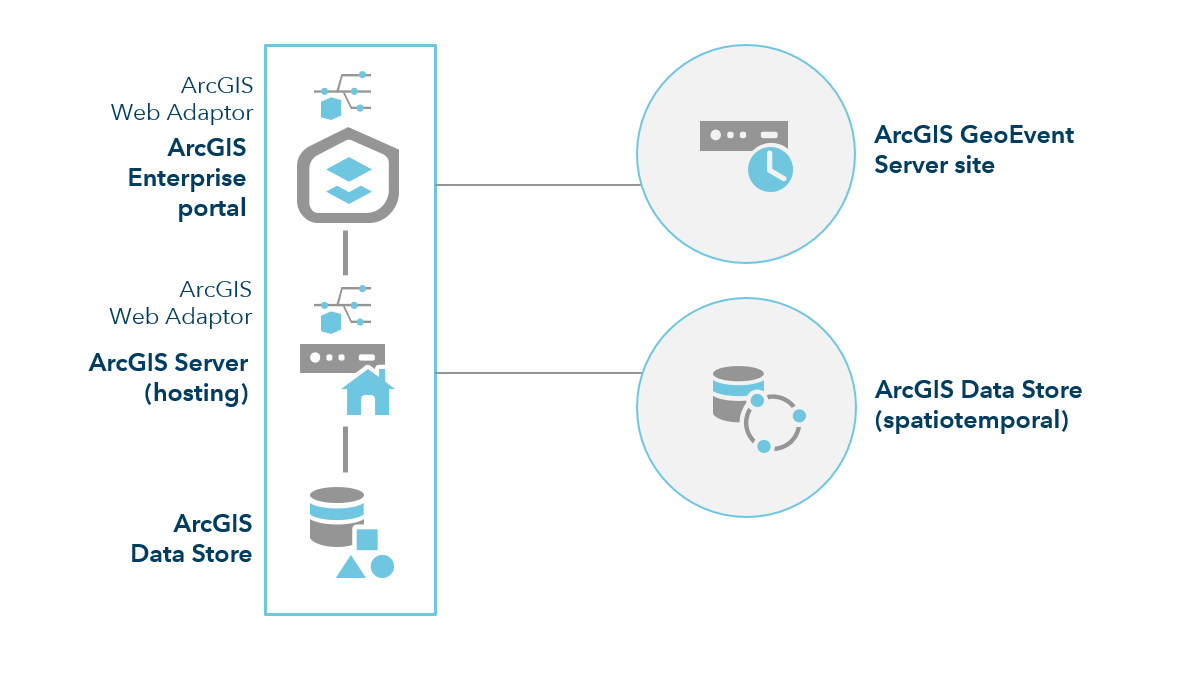
A more minimal set up in which you deploy and license ArcGIS GeoEvent Server on an existing base ArcGIS Enterprise machine is supported. However, system architects should understand the implications of system resource sharing between ArcGIS GIS Server and ArcGIS GeoEvent Server before such a solution is moved into production.
If your real-time sensor network includes multiple data streams, each with a moderate event volume and velocity, configure multiple single-machine ArcGIS GeoEvent Server sites, each dedicated to specific real-time data streams. The diagram below depicts such a configuration, with three independent ArcGIS GeoEvent Server instances, each in their own ArcGIS Server site.
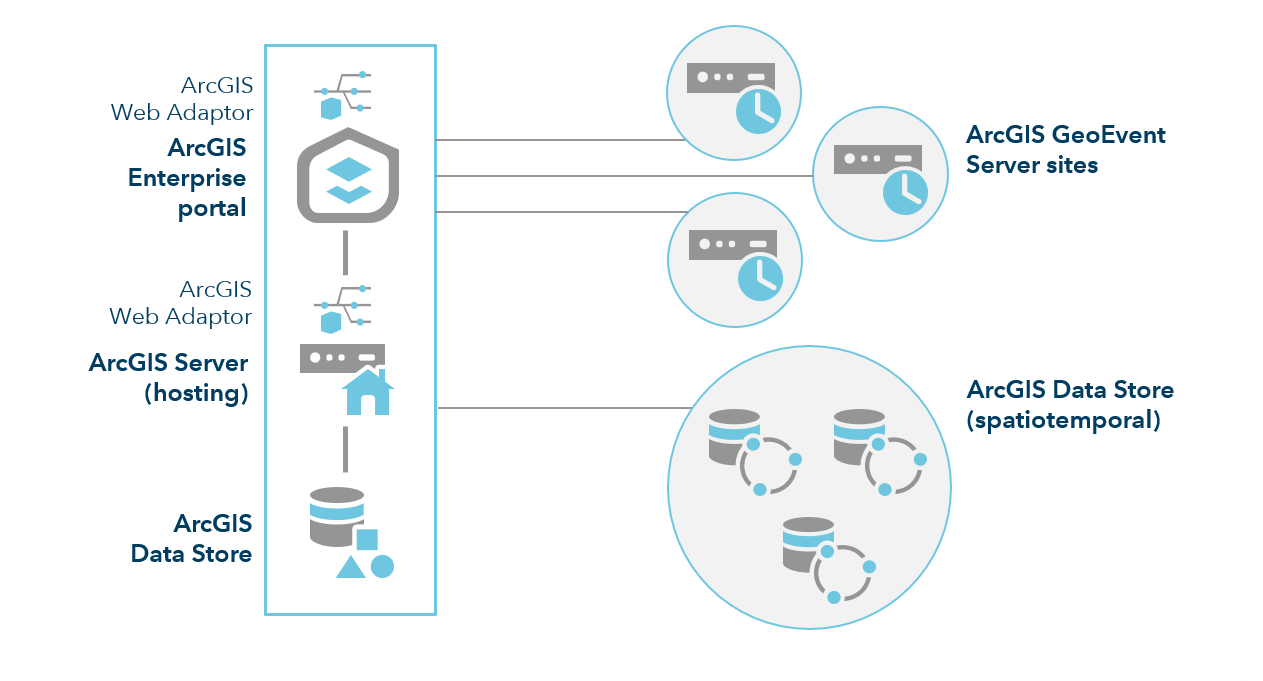
In addition to three independent ArcGIS GeoEvent Server instances, the configuration above illustrates a three-node spatiotemporal big data store registered with your hosting server. The GeoEvent Server and spatiotemporal big data store have been scaled out at the same ratio in this scenario; however, this is not a requirement. For example, your deployment might consist of three instances of GeoEvent Server and a four-node spatiotemporal big data store.
Note:
GeoEvent Server sites are not configured with a web adaptor.
Third-party technologies may be used to support load balancing when distributing sensor data for processing. System administration, however, cannot generally be supported through a load balancer.
- Learn more about system requirements for ArcGIS GeoEvent Server.
ArcGIS Image Server
ArcGIS Image Server provides two primary capabilities: dynamic image services from mosaic datasets and raster analysis using distributed processing.
If you will only be using dynamic image services, the recommended deployment pattern is to add a dedicated ArcGIS Image Server site to the base ArcGIS Enterprise deployment.
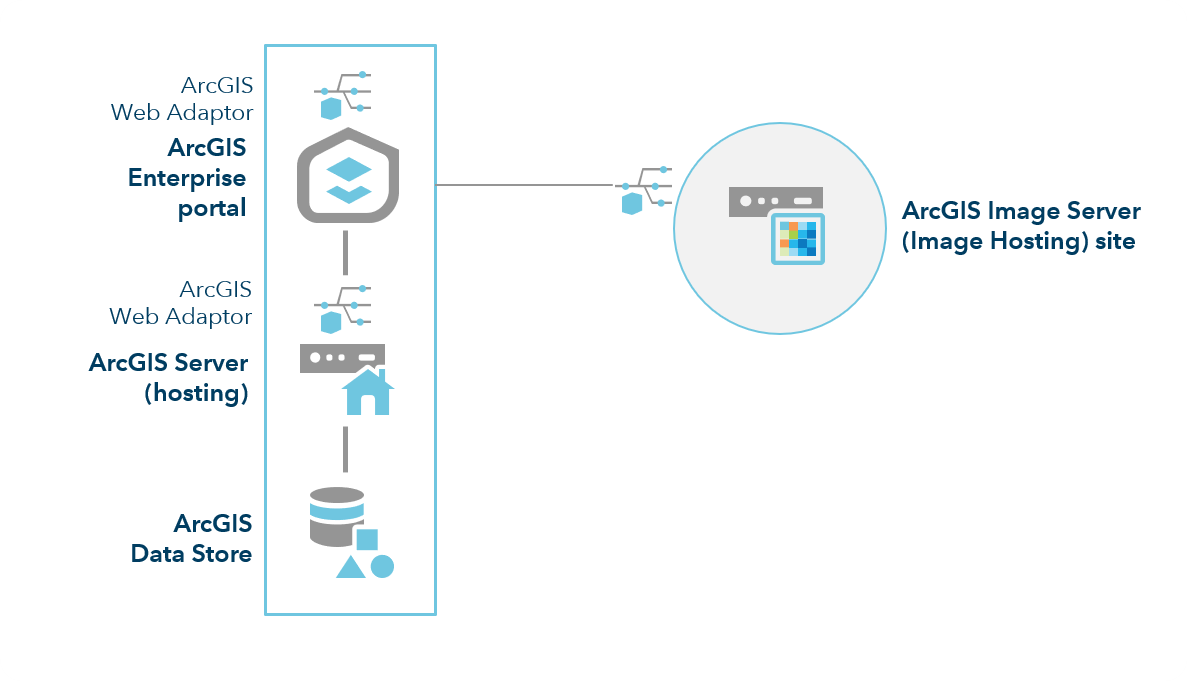
You can also federate additional ArcGIS Image Server sites to this deployment pattern as needed.
- See What is ArcGIS Image Server for more information.
For deployments in which raster analysis will regularly be performed on large datasets, to ensure that dynamic image services are not negatively impacted, use separate sites for raster analysis and dynamic image services.

In such a deployment pattern, you must have a minimum of 8 GB of RAM per machine.
- Learn how to configure and deploy raster analytics.
Note:
You can only have one ArcGIS Image Server site dedicated to raster analytics in an ArcGIS Enterprise deployment. You can scale the site by adding more RAM or additional machines.ArcGIS Knowledge Server
The ArcGIS Knowledge Server role enables ArcGIS Enterprise to model relationships between entities using knowledge graph layers.
To federate an ArcGIS Knowledge Server site to your base ArcGIS Enterprise deployment, you must also add an ArcGIS Data Store configured as a graph data store that is installed on its own machine.
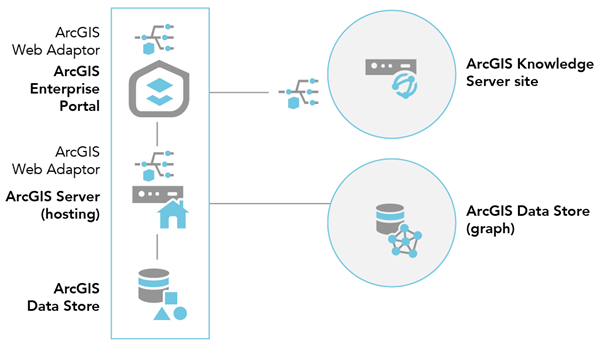
Depending on the complexity and number of analyses you will run on the knowledge graph layer, you may need to add machines to the ArcGIS Knowledge Server site to accelerate your analysis. The diagram below illustrates this deployment pattern and includes a two-machine ArcGIS Knowledge Server site.
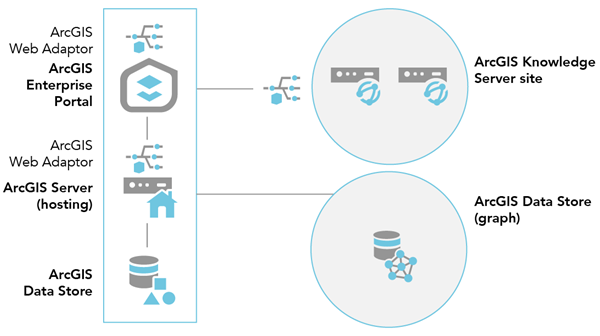
- Learn how to configure ArcGIS Knowledge.
ArcGIS Mission Server
ArcGIS Mission Server provides the processing to facilitate communication between real-time updates in the field and the command center to streamline mission management and inform decision-making.

- See an Introduction to ArcGIS Mission Server for details.
ArcGIS Notebook Server
ArcGIS Notebook Server is a complete data science platform integrated with the ArcGIS Enterprise portal.
The ArcGIS Notebook Server role enables your ArcGIS Enterprise deployment to host and run ArcGIS Notebooks. Using the Python programming language, you can perform spatial analysis, craft data science and machine learning workflows, manage GIS data and content, and automate ArcGIS Enterprise administrative tasks.
ArcGIS Notebook Server sites are configured and federated with an ArcGIS Enterprise deployment. An instance of ArcGIS Web Adaptor is deployed and configured with each ArcGIS Notebook Server site.

ArcGIS Notebook Server uses containers—virtualized operating systems—to provide each notebook author with their own isolated working environment and computing resources within the machine. To allocate and maintain these containers, ArcGIS Notebook Server works with Docker container software. For ArcGIS Notebook Server to function, Docker Engine must be installed and configured on the same machine. The complete steps to set up Docker Engine are contained in the ArcGIS Notebook Server installation guide.
To accommodate many notebook authors, or to provide each author with a larger containerized workspace, you can join multiple machines to an ArcGIS Notebook Server site.
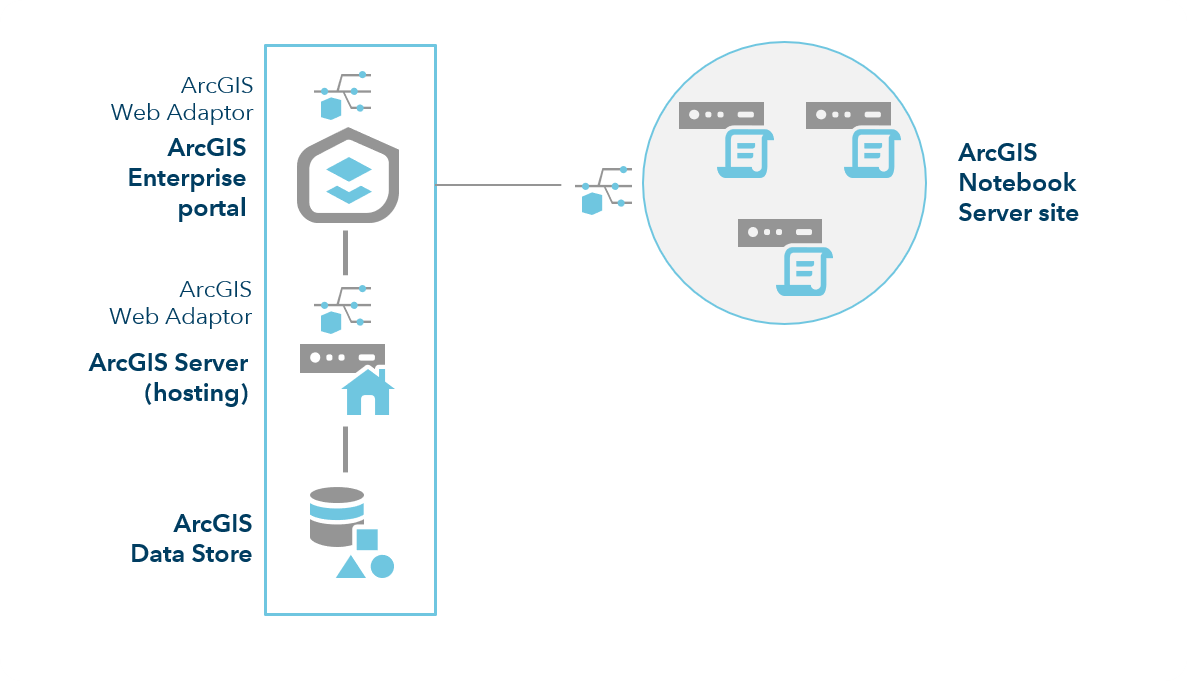
- See an Introduction to ArcGIS Notebook Server for additional details.
ArcGIS Reality Server (beta)
ArcGIS Reality Server (beta) provides distributed computing and storage systems that power reality mapping capabilities for large collections of drones, digital aerial and satellite images.

An ArcGIS Reality Server site is configured and federated with an ArcGIS Enterprise base deployment. The recommended deployment pattern includes a dedicated image hosting server site, and a multi-machine ArcGIS Reality Server site. Both sites require a raster store to store processed outputs. The workload separation in this pattern ensures that reality mapping processing resources don't compete with image service hosting, to maximize efficiency for both functions.
- See What is ArcGIS Reality Server for additional details.
ArcGIS Video Server
ArcGIS Video Server allows you to index, search, publish, and stream videos as web-enabled video services with geospatial and temporal context. It delivers video services to client apps such as ArcGIS Excalibur to play geospatial videos with map telemetry, stream live videos for near real-time insights, and conduct video analyses.
An ArcGIS Video Server site is configured and federated with an ArcGIS Enterprise base deployment. An instance of ArcGIS Web Adaptor is deployed and configured with each ArcGIS Video Server site. ArcGIS Video Server can be installed on its own machine or on the same machine as the hosting server. Once your ArcGIS Video Server site is federated, designate it as the Video Server role.
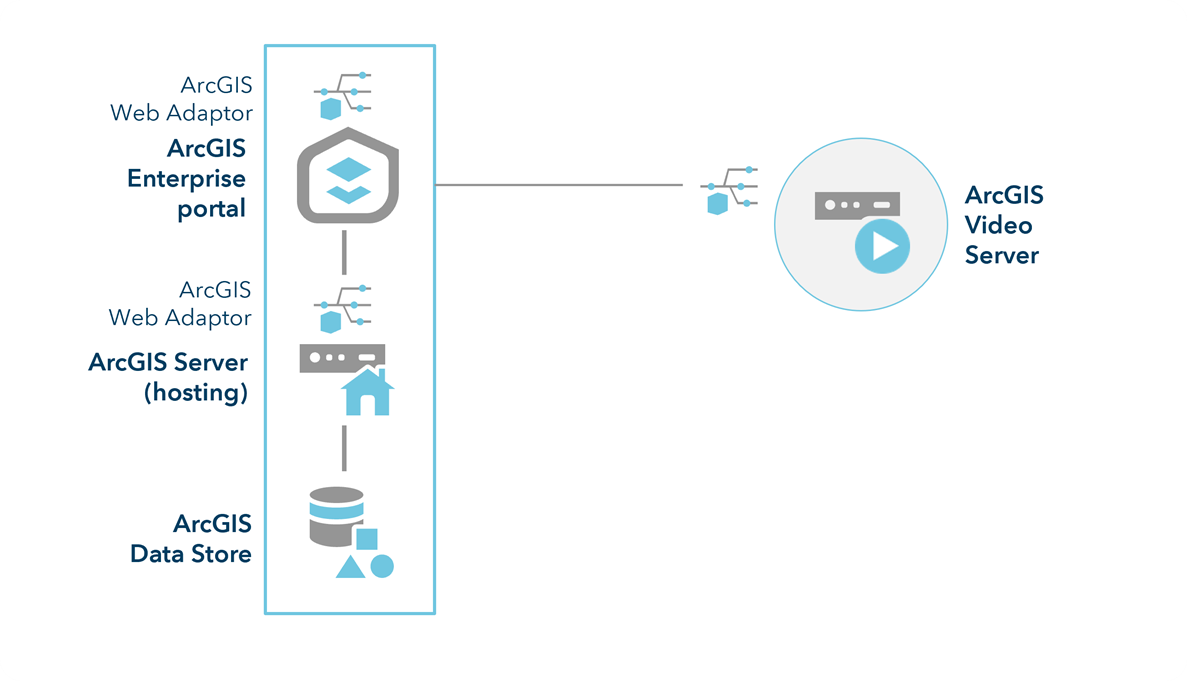
- Learn how to Install and configure ArcGIS Video Server.
ArcGIS Workflow Manager Server
ArcGIS Workflow Manager Server is a scalable workflow management system that automates and simplifies many aspects of performing and managing GIS and non-GIS work in your organization. It includes a web app that is integrated with ArcGIS Enterprise.
An ArcGIS Workflow Manager Server site is configured and federated with an ArcGIS Enterprise deployment. An instance of ArcGIS Web Adaptor is deployed and configured for the ArcGIS Workflow Manager Server site. ArcGIS Workflow Manager Server can be installed on its own machine or on the same machine as the hosting server.
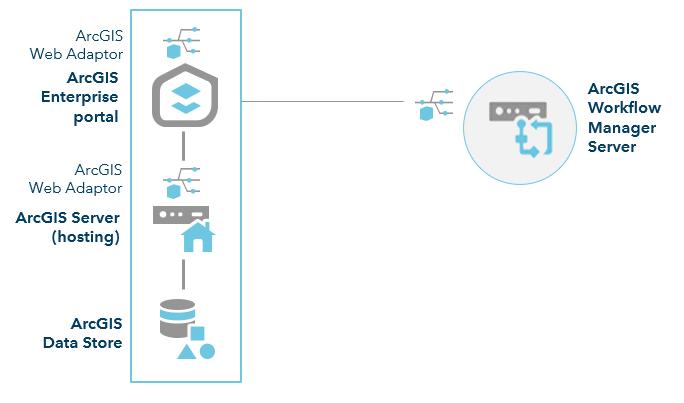
- See an Introduction to ArcGIS Workflow Manager for additional details.